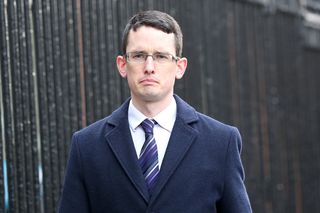City exhumes its ghosts...70 years after bombing of Dresden
It's 70 years and a day since 800 RAF bombers dropped 4,500 tonnes of explosives on Dresden. Now old wounds are being reopened.
On Ursula Elsner's sideboard, Dresden survives intact. At the centre stands a model of the Church of Our Lady, the Frauenkirche, with worshippers lining up in the shadow of its dome. Above the model, an old watercolour of the city's baroque skyline hangs on the wall.
It could have been painted any day of Mrs Elsner's childhood, when she lived so close to the church, where her father was the verger, that it became a second playroom.
Any day until February 13, 1945, that is. That is the day, she says now, when her childhood ended. As 4,500 tons of explosives fell from 800 British planes, 25,000 Dresdeners died in a raging firestorm and the heart of their historic city was obliterated. A second wave of bombing, by the US Air Force, followed the next day. The raids were designed to create panic behind the German front line, just as Russian troops advanced.
The 14-year-old and her family survived, but half of her classmates died. The cost of those two days of war was so great that, in the weeks and years that followed, Dresden was invoked by those who questioned the legitimacy of the RAF's strategic bombing campaign. Even Winston Churchill queried whether the bombs might have been "mere acts of terror and wanton destruction".
The city was quickly rebuilt. On February 13, 1955, the restored Church of the Holy Cross (Kreuzkirche) was packed for its reconsecration.
Thirty years later, a crowd of 200,000 gathered for the inauguration of the rebuilt opera house. And, 60 years after its ruins had become an icon of the city's destruction, in 2005, the Frauenkirche reopened.
The contrast between the blackened original stones and their fresh, white counterparts serves as a permanent memorial. "Its wounds have healed," says Rev Sebastian Feydt, pastor of the church. "But the scars still show."
Wounded pride takes longer to heal. The flames that skipped through Dresden have long since died out, but the passions sparked that night burn on. As the city prepares to mark the 70th anniversary of the raid on Friday, official talk is of reconciliation.
Britain's Archbishop of Canterbury will deliver a sermon in the Frauenkirche, and the Duke of Kent will be presented with a prize for his efforts to reunite the old enemies.
Away from the town hall, some Dresdeners recoil from these overtures. Where once February 13 was a day of quiet contemplation, it has now become a violent clash of historical interpretations. Thousands of neo-Nazis march across the city, hijacking the anniversary to claim moral equivalence between the bombing and the worst crimes of the Third Reich. Even larger crowds of left-wing activists throng the streets in turn, trying to blockade the fascists' advance.
"We will sit down in the street to stop them demonstrating," says Frank Kohler, a 19-year-old student who will take part in this week's blockade for the third year running. "They can't be allowed to abuse this date."
Dresden was never intended to become such a contested chapter of the Second World War. Many more civilians had died during a raid on Hamburg in July 1943, and by the time Dresden was bombed, most other German cities had already been targeted.
Dresden bomber Harry Irons remembers raid 70 years on. For him, a rear gunner who flew 60 raids, the city was "just another target". "It was nothing out of the ordinary," says WO Irons, now 91, who lives in Romford. "I was used to seeing German cities going up in flames and losing my comrades night after night. What went through our minds was just to get there and to get back - we couldn't have any feelings about it."
Listening as I read out his comments, Mrs Elsner, who is now 84 but has never moved from Dresden, stays silent. At last, she nods. "From his perspective, of course," she says. "But for me, that was the worst night of my life. The whole city became one enormous morgue."
She and her seven-year-old brother, Dieter, had been celebrating Shrove Tuesday, and Dieter was still in fancy dress as a tomahawk-toting cowboy when the air-raid sirens began to sound. They sheltered in their cellar, but when they began to be sprinkled with ash, they leapt over a burning timber to hurtle outside, Dieter still clutching his teddy bear.
In the street, sparks singed their hair and hands, but they survived: the families who remained in the cellar all succumbed to carbon monoxide poisoning.
"Everywhere around me was death and destruction," says Mrs Elsner. "I most recall seeing the prams - the babies weren't moving any more."
Yet, even though she remembers that night every day, she is happy to forgive WO Irons and the rest of Bomber Command. "It was war," she says. "We can't talk about blame."
The neo-Nazis are far from the only group seeking to exploit the sense of loss that pervades Dresden. Pegida, a far-right movement of "patriotic Europeans" that began to target disenchanted Germans last year, has shied away from overt references to the bombing, but few think the choice of Dresden for its regular marches is coincidental.
"It ties in with the victimhood running through the city," says Frederick Taylor, the historian and author of Dresden. "The unresolved trauma of 1945 provides a fertile ground for those kinds of feelings."
This exploitation began even as the embers glowed. Nazi propagandists seized on the raid to paint a dark picture of the bombing campaign. Helped by its self-styled image as a "Florence on the Elbe", they claimed the city as an innocent victim of a war crime, omitting to mention the 70,000 workers there who toiled in factories supplying the war effort, or the city's significance as a centre of the railway network and a sizeable barracks.
Even after an official commission of historians settled on the far lower figure of 25,000, the number is still contested, and government press releases about the commemorations explain their workings in lengthy footnotes.
"There are still a lot of people who say it must have been higher - it must have been 100,000," says Matthias Rogg, of the Dresden Military History Museum.
When he quoted the true figure in a newspaper interview to publicise a new exhibition about the bombing, he received hundreds of furious letters.
"I don't think this will ever become just history," he says, detailing the emotions still stirred by any reference to the raid. "The debate will never end."
One uncomfortable truth is sometimes overlooked in all the furore.
"You have to ask the question of responsibility," says Col Rogg, pointing to a skyline that once again resembles the landscape in Ursula Elsner's apartment. "The war started in Germany. And, that night, it came back to us."
Daily Telegraph.
Join the Irish Independent WhatsApp channel
Stay up to date with all the latest news














